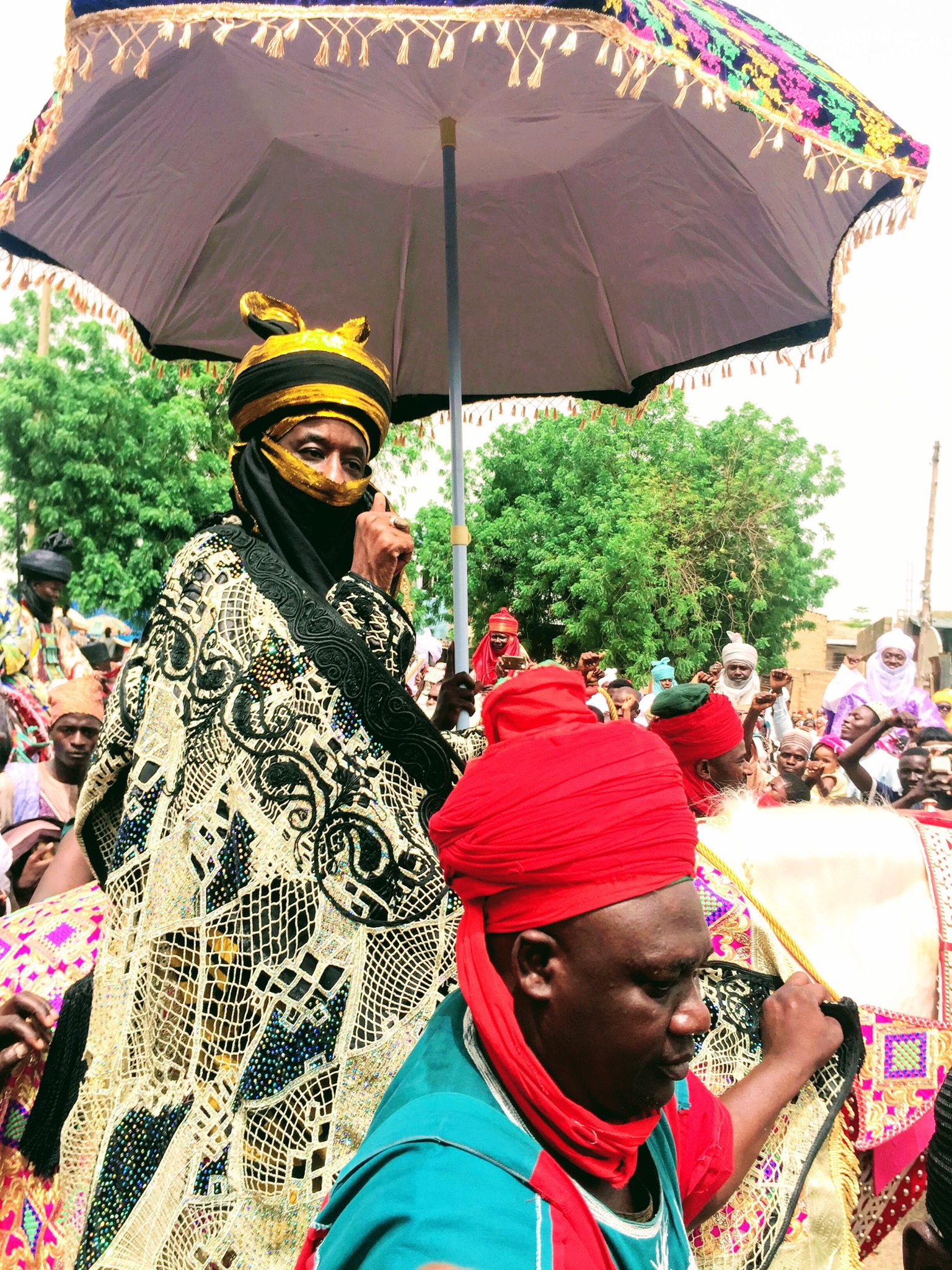
The Emir of Kano, Muhammadu Sanusi II, at Durbar Festival celebrating Eid in June 2018, Kano, Nigeria. Photo by Don Camillo via Wikimedia: CC BY-SA 4.0.
The Kingdom of Kano in northern Nigeria is in trouble.
Governor Abdullahi Umar Ganduje of Kano State in northwestern Nigeria, has decided to split Kano Emirate into five distinct territories, breaking up a kingdom that has existed before the age of governors for nearly 1,000 years.
Dating back to the year 999 as one of Nigeria’s largest kingdoms, Kano played a central role in trans-Sahara commercial routes. Kano is home to a remarkable museum that holds ancient relics in a prominent palace, and Nigerians often gather for festivals and exhibitions.
Ganduje’s decision to split this ancient kingdom under his governance is tied to a political tug-of-war between himself, Kano’s former governor, Rabiu Kwankwaso and the current king, 57-year-old Emir Muhammadu Sanusi II, the 58th Emir (King) to date — appointed by Kwankwaso before his term ended.
Once political allies, Ganduje and Kwankwaso became rivals after Ganduje took office in 2015, and now his decision to split Sanusi’s kingdom is, according to some, an act of revenge against the emir, his rival Kwankwaso's pick.
This adverse situation has disturbed the unity among Kano Kingdom households who have gotten along for centuries.
Counting from the unification in 927, the British Monarchy is about 1,092 years old. Kano Kingdom was founded in 999, 1,020 years old.
While the Brits will do all to uphold the dignity of their royal heritage, Nigeria is dismantling its own heritage over petty politics. Thread.
— Ayò Bánkólé (@AyoBankole) May 8, 2019
On May 10, the courts instructed Ganduje to halt the appointment ceremony of the new kings, but he defied the court and executed the division anyway, claiming he was carrying out the orders of the state legislature.
Several palace officials decried Governor Ganduje’s actions, calling it a distortion of a working model for governance in Kano and northern Nigeria. Ganduje said he did not obey the court order because it came after the appointment of the new emirs in each of the five distinct sub-kingdoms: Kano, Rano, Karaye, Gaya and Bichi.
However, on May 15, the court ordered a return to the status quo pending the hearing of the suit against the appointment of the new emirs.
Many Kano residents, depressed by the division, said Governor Ganduje is playing politics in diminishing the famous Kano Kingdom.

The Emir of Kano on his throne, September 2016. Photo by Don Camillo via Wikimedia: CC BY-SA 4.0.
Political rivalry
Current Governor Ganduje worked as deputy governor to Kwankwaso twice between 2011 and 2015.
When Kwankwaso was about to leave office, he called on Ganduje as his deputy to run in the 2015 election. But since Ganduje took office, Kwankwaso has accused him of not being loyal, although Ganduje denies these charges.
During Nigeria’s 2019 presidential election, Kwankwaso strategized to prevent Ganduje from taking on a second term, but Ganduje prevailed.
Ganduje has expressed hostility toward Sanusi for supporting Kwankwaso’s favored candidate, Abba Kabir, of the People’s Democratic Party, during the 2019 election.
The two rivals have challenged each other with political blackmail through their supporters. Ganduje has revoked all Kwankwaso’s projects that he started as governor.
Ganduje’s move to split the kingdom is revenge against Sanusi’s partisanship and another way to show disdain for Kwankwaso.
He says the five new territories would operate as Kano’s sub-domains within Kano State. Jurisdiction for these territories would fall under Ganduje — instead of King Sanusi.
A history of kingmakers
Before 1903, kingmakers determined the pick of Kano kings through family lineage. But with Europe’s widening influence in West Africa, ruling governors were given the power to choose kings beginning in 1903. Even though a prevailing democratic governor oversees Kano’s Emirate Council, it usually complies with ancestral customs of the kingdom.
Present-day Kano State in northwestern Nigeria was established in 1967 and remains a major economic hub in northern Nigeria, governed by Nigeria’s military and civilian governors.

1850 postcard reproduction of an engraving of Kano Kingdom via Public Domain/Wikimedia Commons.
Ado Bayero became the 57th Emir in 1963, holding sway for 50 years until his death in 2014. After his demise, Emirate families expected Governor Kwankwaso to appoint a descendant of the Bayero family as the next king.
But that year, Kwankwaso, Kano governor, wielded his power granted by the constitution to appoint Muhammad Sanusi as the monarch, instead. Ado Bayero had a tense relationship with Kwankwaso, thus it was “practically impossible” for Kwankwaso to appoint Bayero’s son as emir.
On the other hand, Sanusi has always harbored the ambition to return his lineage to the throne of Kano, which was lost when his grandfather, Emir Muhammadu Sanusi I, was deposed fifty years ago.
Sanusi was Nigeria’s Central Bank governor when Kwankwaso named him as the new king in 2014 and he resigned to accept the mantle as the 58th Emir of Kano Kingdom. That same year, however, BBC reports that Sanusi was ousted by the Central Bank for alleged fraud and mismanagement of millions of dollars in oil revenue.
Sanusi hails from the Sanusi Emirate folk, yet choosing him as the Emir of Kano tore apart Emirate households — most initially rejected Sanusi. The Bayero family also declined to pay homage to the new emir, and pandemonium broke out in Kano city.
But since 2014, Sanusi has contributed to an abundance of reforms in the kingdom and many say he has improved the well being of Emirate families and the Kano community at large — a king ushering in modernity to the ancient kingdom.
Others say Sanusi used monetary influence to win over those who initially defied him.

Kano Emirate families pay their respect to the King Sanusi, 2016. Photo by Don Camillo via Wikimedia: CC BY-SA 4.0.
Split kingdom, halted?
The Kano State House of Assembly Speaker, Alasan Rurum, backs the Ganduje division of the Emirate:
The four emirate councils [Rano, Gaya, Karaye and Bichi] have existed for more than 300 years. It is not a new creation. So, as far as the laws that we passed are concerned, we simply re-introduced what we had on the ground between 300 and 500 years ago.
Meanwhile, some members of Kano State House of Assembly, who oppose Ganduje, petitioned the State government in court, challenging it to oblige the governor to reverse Kano Emirate to its former status.
In the same week that the High Court halted Ganduje along with eight others in splitting the kingdom, a youth group went to Bichi — one of the sub-kingdoms — to pay allegiance to the new king — the son of the late Ado Bayero.
Now, the historical Kano Emirate faces turbulent times by an eager politician attempting with urgency to baffle his political adversary.
What are the consequences? Time will tell.

An edited version of the Kano Wall in the Kano Kingdom. Photo by Cepit via Wikimedia: CC BY-SA 4.0.
Editor's note: Nwachukwu Egbunike contributed to this report.






